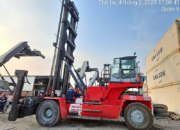Tips when choosing to buy a used forklift
Before deciding to buy a used forklift, research is an important first step before you buy a used forklift. There are four main steps in the research process:
Learn the basics
Learn and understand basic forklift specifications
To understand more about the parameters, we can find out more on the catalog or the technical information posted on the website by the manufacturer.

Must state your usage requirements
Create a detailed list of what criteria to use in a forklift, potentials that must be met
For example: budget, vehicle depreciation time, vehicle weight, vehicle size, type of vehicle material used such as electric forklift, gas forklift, diesel forklift, characteristics of goods, working height…
Researching many models of cars with similar functions
Use a variety of information sources such as former users that you know, official sources of information from reputable websites, find out information from reputable agents and suppliers…
Find out about suppliers
Before going to the dealers, prepare relevant questions to ask the agents in advance
Examples of reference questions: Year of manufacture, time of use, major repairs, types of spare parts still in production and easy to find in the market? Test certificates…
After completing step 4, your final advice is to buy your car from a trusted dealer. A trusted dealer can provide you with accurate information about your used forklift, which will eliminate any misrepresentations with the actual vehicle and provide better warranty care.
The last step is to check the actual car
Here are some recommendations to consider before testing:
Collect and read documents, operating history if any
Ask an experienced forklift specialist to help you assess the quality and other problems of your vehicle
Ask about warranty
How long is the supplier warranty? What is the warranty like, is it possible to negotiate an extended warranty when buying the car?
Your final inspection to evaluate the used forklift you intend to purchase; You need to ensure that all parts, attachments and features are operating to a standard that suits your needs.
It is recommended that a mechanic be present to provide a clear assessment of the forklift.







